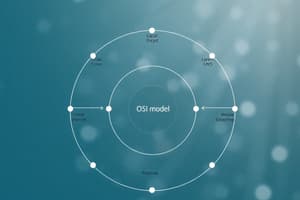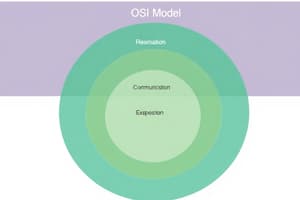Podcast
Questions and Answers
What is the primary role of the Application Layer in the OSI Model?
What is the primary role of the Application Layer in the OSI Model?
- To offer services directly to the user. (correct)
- To manage error detection and correction.
- To establish network connections.
- To provide transmission control services.
Which of the following correctly identifies the term used for data at the Data Link Layer?
Which of the following correctly identifies the term used for data at the Data Link Layer?
- Packet
- Segment
- Frame (correct)
- Bits
What process describes removing control information as data moves up through the OSI Model?
What process describes removing control information as data moves up through the OSI Model?
- Transmission
- Decapsulation (correct)
- Transformation
- Encapsulation
Which name is given to a Protocol Data Unit (PDU) at the Transport Layer?
Which name is given to a Protocol Data Unit (PDU) at the Transport Layer?
In OSI model encapsulation, which layer is responsible for the representation of user interface to the network?
In OSI model encapsulation, which layer is responsible for the representation of user interface to the network?
Which of the following is NOT a valid PDU name in the TCP/IP suite?
Which of the following is NOT a valid PDU name in the TCP/IP suite?
What is the function of the Network Layer in the OSI model?
What is the function of the Network Layer in the OSI model?
During the encapsulation process, what happens to the data as it descends through the layers?
During the encapsulation process, what happens to the data as it descends through the layers?
What is one of the key objectives of the OSI model?
What is one of the key objectives of the OSI model?
Which layers of the OSI model are categorized as user support layers?
Which layers of the OSI model are categorized as user support layers?
What process occurs when a packet passes down through the OSI layers?
What process occurs when a packet passes down through the OSI layers?
What allows layer n in one machine to communicate with layer n in another machine?
What allows layer n in one machine to communicate with layer n in another machine?
In which layer of the OSI model does encapsulation begin?
In which layer of the OSI model does encapsulation begin?
Which of the following statements about the OSI model is incorrect?
Which of the following statements about the OSI model is incorrect?
What is the main role of the Transport Layer in the OSI model?
What is the main role of the Transport Layer in the OSI model?
Which of the following layers is responsible for session management between applications?
Which of the following layers is responsible for session management between applications?
What is the primary function of the Network Access Layer in the TCP/IP model?
What is the primary function of the Network Access Layer in the TCP/IP model?
Which of the following protocols is part of the TCP/IP protocol suite?
Which of the following protocols is part of the TCP/IP protocol suite?
How many layers are defined in the original TCP/IP protocol suite?
How many layers are defined in the original TCP/IP protocol suite?
Which layer of the TCP/IP model is primarily responsible for the logical addressing of devices?
Which layer of the TCP/IP model is primarily responsible for the logical addressing of devices?
What is the purpose of the encapsulation process in networking?
What is the purpose of the encapsulation process in networking?
Which of the following represents a common Peer-to-Peer process in the TCP/IP model?
Which of the following represents a common Peer-to-Peer process in the TCP/IP model?
What does the term Protocol Data Unit (PDU) refer to in the context of the TCP/IP model?
What does the term Protocol Data Unit (PDU) refer to in the context of the TCP/IP model?
How does the TCP/IP model differ from the OSI model in terms of layer organization?
How does the TCP/IP model differ from the OSI model in terms of layer organization?
Flashcards
OSI Model
OSI Model
A layered framework for network communication, defining how data is transmitted and received.
Encapsulation
Encapsulation
Adding control information to data as it travels down the OSI layers.
Decapsulation
Decapsulation
Removing control information as data moves up the OSI layers.
Protocol Data Unit (PDU)
Protocol Data Unit (PDU)
Signup and view all the flashcards
Data Link Layer
Data Link Layer
Signup and view all the flashcards
Application Layer
Application Layer
Signup and view all the flashcards
Presentation Layer
Presentation Layer
Signup and view all the flashcards
Transport Layer
Transport Layer
Signup and view all the flashcards
ARPANET
ARPANET
Signup and view all the flashcards
TCP/IP Model
TCP/IP Model
Signup and view all the flashcards
TCP/IP Protocol Suite
TCP/IP Protocol Suite
Signup and view all the flashcards
Interface Message Processor (IMP)
Interface Message Processor (IMP)
Signup and view all the flashcards
Network Access Layer
Network Access Layer
Signup and view all the flashcards
Internet Layer
Internet Layer
Signup and view all the flashcards
Transport Layer
Transport Layer
Signup and view all the flashcards
Application Layer
Application Layer
Signup and view all the flashcards
OSI Model Layers
OSI Model Layers
Signup and view all the flashcards
Network Support Layers
Network Support Layers
Signup and view all the flashcards
User Support Layers
User Support Layers
Signup and view all the flashcards
Transport Layer
Transport Layer
Signup and view all the flashcards
Encapsulation
Encapsulation
Signup and view all the flashcards
Peer Processes
Peer Processes
Signup and view all the flashcards
OSI Model Objectives
OSI Model Objectives
Signup and view all the flashcards
Decapsulation
Decapsulation
Signup and view all the flashcards
Study Notes
Computer Networks - Chapter 2: Network Models
- Layered Architecture: The concept of layers is used in daily life (e.g., sending a letter through the post office). Layers provide a hierarchy of tasks, with higher layers interacting with middle layers, then lower layers. Each layer relies on the services of the layer below. Reference models like OSI and TCP/IP make network implementations more manageable and understandable by dividing complex functions into simpler components. They improve vendor interoperability and aid in data transfer understanding.
OSI Reference Model Architecture
-
OSI Model Objectives: The Open Systems Interconnection (OSI) model, an ISO standard, defines a seven-layer architecture for network communications and aims to allow different devices to communicate regardless of their architecture. It standardizes components, facilitates communication between hardware and software, prevents layering interference, and facilitates learning.
-
OSI Seven Layers: The OSI model comprises these seven layers: Physical, Data Link, Network, Transport, Session, Presentation, and Application. Each layer performs specific tasks in the network.
-
Peer-to-Peer Communication: Layer n in one machine interacts with layer n in another, providing a service for layer n+1. Entities in corresponding layers communicate to perform actions.
-
Encapsulation/Decapsulation: Encapsulation adds control information as data moves down layers. The data portion gets headers and/or trailers added at each layer. Decapsulation is the reverse process of removing headers and trailers as data moves up layers. Each layer's protocol data unit (PDU) has a different name (e.g., data, segment, packet, frame, bits) at each stage.
TCP/IP Model and Protocol Suite
-
TCP/IP Model History: The TCP/IP model's predecessor, ARPANET, emerged in 1969. Robert Kahn and Vinton Cerf developed TCP in 1973, eventually leading to the TCP/IP suite. This suite evolved with additions like Telnet, FTP, DNS and others.
-
TCP/IP Model versus OSI Model: The TCP/IP model has four layers, Network Access Layer, Internet Layer, Transport Layer, and Application Layer, compared to the OSI model's seven layers. Their transport and network layers show similarities.
-
TCP/IP Protocol Suite: The suite includes protocols for diverse tasks (e.g., email, file transfer, remote access). It's an open standard, overseen by the IETF Working Groups, using RFCs for standards.
Functions of Each Layer in OSI Model
-
Application Layer: Provides services for the user to interact with the network. Examples include email (SMTP, POP3), web browsing (HTTP, HTTPS), file transfer (FTP), remote access (Telnet, SSH), and DNS.
-
Presentation Layer: Deals with common representation of data between application layers, coding/conversion, compression/decompression and encryption/decryption.
-
Session Layer: Provides services to the presentation layer to organize dialogs and manage data exchange, enabling session establishment, management, termination, and dialogue control.
-
Transport Layer: Provides reliable and efficient end-to-end transport of packets, handling connection control, service port addressing, segmentation, reassembly, sequencing, error control, and flow control (e.g., TCP, UDP).
-
Network Layer: Delivers individual packets from the source to the destination host, using functions like logical addressing (e.g., IPv4, IPv6, IPX) and routing to determine the best path. (e.g., RIP, OSPF, IS-IS, EIGRP, BGP).
-
Data Link Layer: Moves frames between hops, implementing functions like framing, physical addressing (e.g., MAC addresses in Ethernet), hop-to-hop error controls, hop-to-hop flow control and access control (e.g., HDLC, PPP).
-
Physical Layer: Responsible for moving individual bits over a physical medium, specifying physical characteristics of interfaces, representation of bits, data rate, synchronization, line configuration and physical topology. It details communication links (e.g., twisted-pair cable, coaxial cable, optical fiber, radio, satellite).
Studying That Suits You
Use AI to generate personalized quizzes and flashcards to suit your learning preferences.
Related Documents
Description
This quiz covers the concepts of layered architecture and the OSI reference model as discussed in Chapter 2 of Computer Networks. Learn how the OSI model defines a seven-layer architecture and its objectives in enabling communication between different systems. Enhance your understanding of network models and their applications.



